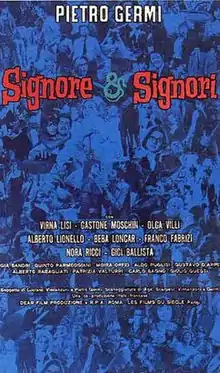The Birds, the Bees and the Italians
The Birds, the Bees and the Italians is a 1966 italian film directed by Pietro Germi. Its original Italian title is Signore & Signori, which means 'Ladies and Gentlemen'.
| Signore & Signori (The Birds, the Bees and the Italians) | |
|---|---|
 Original film poster | |
| Directed by | Pietro Germi |
| Written by | Age Pietro Germi Luciano Vincenzoni |
| Starring | Virna Lisi Gastone Moschin Nora Ricci |
| Cinematography | Aiace Parolin |
| Music by | Carlo Rustichelli |
| Distributed by | Dear Film |
Release dates |
|
Running time | 115 minutes |
| Countries | Italy France |
| Language | Italian |
Plot
The film is set in an unspecified town in the Veneto region, which is indicated in the sign of the local newspaper as Rezega (and the cars have an imaginary RZ license plate). The plot revolves around the vicissitudes of a company of merchants and professionals from the middle-upper middle class who, behind an impeccable facade of respectability, hide a dense, implied plot of mutual betrayals.
As anthology film, presents three storylines. In the first story, Toni Gasparini, as much admired as feared by his friends, confesses to Dr. Castellan, a doctor and friend, that he has been powerless for many months now, to make him lower his guard against his young and vivacious wife Noemi. The doctor spreads his confidence with insensitive lightness in his circle of friends, for the pure pleasure of his gossip, unaware that he is supporting his plan. At the end of a party, Castellan, together with the others, continues the fun night in a night club and allows Toni to take Noemi home. When a friend, incredulous of the rumor of Gasparini's impotence, reveals that he witnessed the man's latest adventure some ten days earlier, the doctor rushes home, but arrives too late to prevent his willing wife from being seduced and is forced to hide what happened, to save his honor.
In the second, the accountant Osvaldo Bisigato, a modest bank employee, afflicted by a wife, Gilda, oppressive and rancorous, who constantly reproaches him for failures and lack of ambition, believes he can start a new life by running away with Milena Zulian, the young and beautiful cashier of the bar attended by the whole party, who reciprocate his interest. But, while cheating is tacitly permitted, separation is not socially acceptable, and so the whole town unites against him: his wife's cousin (the influential Ippolita, Gasparini's wife), the same "friends" or presumed such; the employer, the parish priest and even the commander of the Carabinieri: all to force him to retrace his steps and maintain the illusion of the sanctity of the conjugal union. Don Schiavon convinces Milena to leave the city and Bisigato, after a suicide attempt and hospitalization, returns to the ranks submissive and resigned.
In the third, Alda Cristofoletto, a young and beautiful country girl, who arrived in the city to shop, does not go unnoticed in the eyes of a group of womanizing friends, who one after another they take advantage of his availability. But the next day the farmer Bepi Cristofoletto, father of the girl, just sixteen, denounces them all for corruption of a minor. To prevent the community from being marked by scandalof the trial, while the economic "potentate" and the religious authorities silenced the local press (a series of phone calls asked the reporter Tosato to delete one name, another, until there was no guilty person left in the piece), the icy and calculating Ippolita, wife of one of the accused, convinces the naive and honest farmer Cristofoletto to withdraw the complaint, offering him in exchange a large sum of money and giving it to him, thus satisfying his carnal desires and keeping for himself (or better for the poor) a large part of the money raised for "brokerage".
The film shared the Grand Prix with A Man and a Woman at the 1966 Cannes Film Festival.[1] It was later selected for screening as part of the Cannes Classics section at the 2016 Cannes Film Festival.[2]
In 2008, the film was included on the Italian Ministry of Cultural Heritage’s 100 Italian films to be saved, a list of 100 films that "have changed the collective memory of the country between 1942 and 1978."[3]
Cast
- Virna Lisi – Milena Zulian
- Gastone Moschin – Osvaldo Bisigato
- Nora Ricci – Gilda Bisigato
- Alberto Lionello – Toni Gasparini
- Olga Villi – Ippolita Gasparini
- Franco Fabrizi – Lino Benedetti
- Beba Lončar – Noemi Castellan
- Gigi Ballista – Giacinto Castellan
- Carlo Bagno – Bepi Cristofoletto
- Patrizia Valturri – Alda Cristofoletto
- Virgilio Gazzolo – Newspaper editor
- Quinto Parmeggiani – Giovanni Soligo
- Gia Sandri – Betty Soligo
- Moira Orfei – Giorgia Casellato
- Virgilio Scapin – Don Schiavon
References
- "Festival de Cannes: The Birds, the Bees and the Italians". www.festival-cannes.com. Retrieved 8 March 2009.
- "Cannes Classics 2016". Cannes Film Festival. 20 April 2016. Retrieved 21 April 2016.
- "Ecco i cento film italiani da salvare Corriere della Sera". www.corriere.it. Retrieved 2021-03-11.
External links